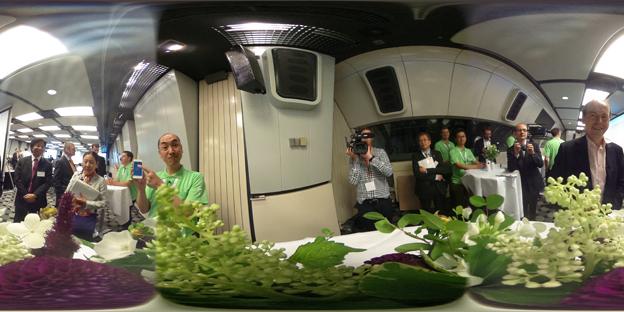Standing out from the IFA crowd
- Published
- comments

Where's Rory? (picture taken with Ricoh 360 camera)
Visiting a big technology show such as Berlin's IFA is an exhausting experience.
As I wander endlessly across a vast site from which no escape seems possible, deafened by music from competing stands, disoriented by the flickering images from a thousand screens, I'm reminded of Hunter S Thompson's wonderful (though perhaps apocryphal) line about the TV industry: "A cruel and shallow money trench, a long plastic hallway where thieves and pimps run free, and good men die like dogs. There's also a negative side."
Actually, despite the mayhem, it is worth coming because there are always a few products which stand out from the crowd and give a hint of where technology is heading. Here are three that I spotted on my travels.
CSR Ultra Thin Keyboard
The BBC's Technology correspondent Rory Cellan-Jones spoke to CSR's Paul Williamson about applications for the keyboard
In shows dominated by products from American and Asian firms, it is great to spot a British success story. Cambridge-based CSR were showing off their ultra-thin flexible keyboard which uses the firm's Bluetooth Smart chip to connect to a tablet or a smartphone. The technology can be incorporated in a cover, or could be used to turn any surface into a touchscreen or a digital drawing pad.
CSR won't itself be turning its prototype into a product but is already getting plenty of interest from potential partners. The fast-growing business is also promising lots of other interesting uses for Bluetooth Smart - Apple is a major proponent, so look out for possible announcements from California in the near future.
Ricoh 360 Camera
There seems to be no limit to the innovations offered to photographers - from ultra small action cameras, to the stand-alone smartphone lenses unveiled by Sony here.
Japan's Ricoh thinks the next big thing is 360-degree shots. Its Theta device has two fish-eye lenses which capture light from every direction. You can press the button yourself, which means a guaranteed selfie, or retire from the scene and control the camera via a smartphone app. The results can then be viewed and shared via the phone - and you can also use Microsoft's Photosynth app to manipulate the images.
Rory Cellan-Jones takes a look at the Ricoh Theta
The results are rather pleasing - click on this for one example, external - though it is hard to imagine there will be a huge market for a device that will cost £329. But more affluent smartphone users will find this accessory takes better pictures than Samsung's new smart watch.
Haier Eye Control TV
Television remains the centrepiece of any technology show - and there are plenty of stunning screens, whether it is OLED or 4K or a TV with facial recognition so that you can stop your children getting access at certain times.
But what stood out was a television you could control just by looking at it, made by the Chinese firm Haier. The technology was first unveiled a year ago, but was rather clunky at that stage - now it looks ready for the market.
First, you calibrate the eye-tracking by following a dot around the screen, then the small sensor placed between you and the TV tracks your eye movements. Without moving your head you can then bring up different menus, change the volume or select multimedia content just by looking at different areas of the screen - and then blinking.
Rory Cellan-Jones has a go at controlling a television with his eyes
It takes a few minutes to get the hang of it, but soon I was scanning through menus, shuttling through a choice of films and turning up the volume at the blink of an eye. Whether this will ever have an application beyond people with very limited mobility seems doubtful - but unlike so much of what's on display here it certainly had the wow factor. And another thing impressed us.
We arrived on the Haier stand while it was still being built and the eye-control set wasn't hooked up - but a couple of technicians leaped into action and made everything work. That can-do attitude is typical of the Chinese firms I've encountered, and should be a warning to complacent technology companies operating at a slower pace.